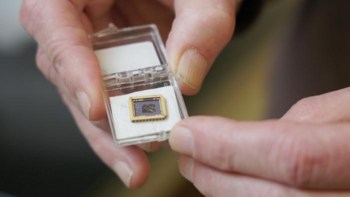
The first experimental evidence of a quasiparticle known as a type-II Dirac fermion has been found by three independent research groups – one based in South Korea and two in China. Two of the groups found signs of the quasiparticle in the crystalline material palladium ditelluride. This could mean that the material is a topological superconductor – a hypothetical material with unique properties that could be useful as components in the proposed technology known as a topological quantum computer. The third group found evidence for type-II Dirac fermions in a similar material called platinum ditelluride.
Dirac fermions are subatomic particles with half-integer spin that are not their own antiparticles. Electrons in solids can also exhibit particle-like collective behaviour that can be described in terms of Dirac-fermion quasiparticles, which obey the same physics as their subatomic counterparts. These quasiparticles can exist as a so-called topological phase of matter with unique properties that condensed-matter physicists think could eventually be useful in quantum computing.
A type-II Dirac fermion is a special type of Dirac fermion that has a specific electronic band structure resembling a tilted cone. Prior theoretical calculations suggested that they could be lurking in palladium ditelluride, says Han-Jin Noh of Chonnam National University, who is a member of the South Korean group. To confirm this, his team used a technique called angle-resolved photoemission spectroscopy (ARPES), in which high-energy photons strike the material from different directions, causing the material to emit electrons. The researchers measure the energy and momenta of the emitted electrons and use that data to map out the material’s electronic band structure.
Telltale sign
ARPES measurements were also carried out on platinum ditelluride by Mingzhe Yan from Tsinghua University. Both teams found that the conduction and valence bands meet at a single point called a Dirac or Weyl point. This point is the telltale sign that the materials could harbour Dirac fermions – and in this case, type-II Dirac fermions, because of the specific geometries of the materials’ band structures.
Meanwhile, a group that included Xiangang Wan of Nanjing University in China performed a different type of measurement on palladium ditelluride. The researchers placed the material in a magnetic field and measured its resistivity, which oscillated back and forth. These Shubnikov–de Haas oscillations are also a consequence of the Dirac-point geometry in the material’s electronic band structure, Wan says.
Noh says that the evidence for Dirac fermions in palladium ditelluride is exciting, particularly because the material is also a superconductor below 1.7 K. Since it is a superconductor and can host topological states, it could be an exotic new material known as a topological superconductor. “We still don’t know whether it is a topological superconductor, but we expect it might be,” Wan says.
Anyone for anyons?
Topological superconductors have different properties compared with regular superconductors, says Alexey Soluyanov of ETH Zürich in Switzerland, who was not involved in the research. They could host another sought-after quasiparticle known as an anyon. Anyons could be used in topological quantum computers, a proposed type of quantum computer that relies on topological states of matter that should be more stable than the quantum computers currently being built.
But these technologies are all speculative, and now the teams need to show that the palladium ditelluride actually is a topological superconductor. The groups are also focused on understanding the basic science of these quasiparticles and exotic states of matter. Noh’s group plans to introduce impurities into the material to make its exotic properties easier to access in experiments. “Academically, they are really interesting things,” Noh says. “They’re really something new in the condensed-matter physics world.”
The research is described in Physical Review Letters, Physical Review B and arXiv.



